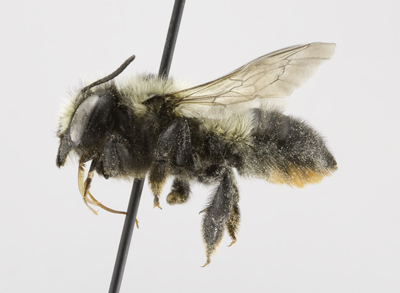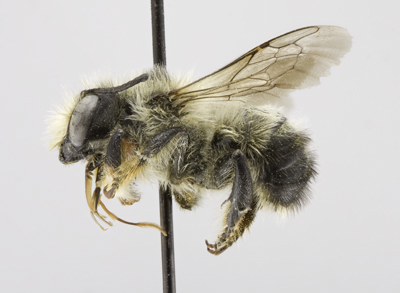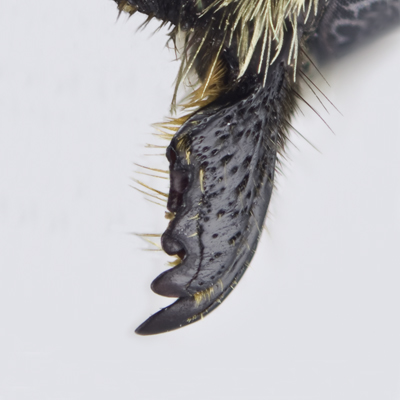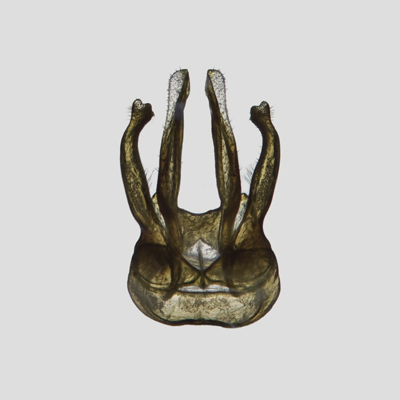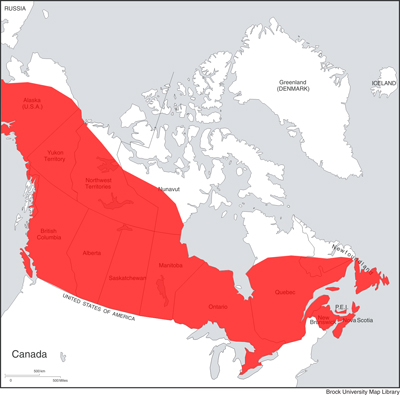
37. Megachile (Xanthosarus) melanophaea Smith, 1853
Megachile melanophaea Female |
Megachile melanophaea Male |
Megachile melanophaea Smith, 1853. Cat. Hym. Brit. Mus. 1: 191 (♀, ♂).
Megachile femorata Provancher, 1882. Nat. Canad. 13: 228 (♂) (preoccupied).
Megachile wootoni Cockerell, 1898a. Ann. Mag. Nat. Hist. (7) 1: 125 (♂).
Megachile calogaster Cockerell, 1898b. Proc. Ac. Nat. Sc. Phil. 50: 55 (♂).
Megachile canadensis Friese, 1903. Ztschr. System. Hym. Dipt. 3: 248 (replacement name for M. femorata Provancher, 1882, not Smith, 1879).
Megachile wootoni rohweri Cockerell, 1906b. Amer. Mus. Nat. Hist. Bull. 22: 453 (♀).
Megachile pseudolatimanus Strand, 1917. Arch. Naturges. 83A (11): 65 (♂).
Megachile tuala Strand, 1917. Arch. Naturges. 83A (11): 66 (♀).
Megachile (Delomegachile) melanophaea submelanophaea Mitchell, 1935b. Trans. Amer. Entomol. Soc. 61: 197 (♀).
Megachile (Delomegachile) melanophoea melanophoea Mitchell, 1962. North Carolina Agric. Exper. Stat. Tech Bull. 152: 138 (misspelling of M. melanophaea melanophaea).
Megachile (Delomegachile) melanophoea submelanophoea Mitchell, 1962. North Carolina Agric. Exper. Stat. Tech Bull. 152: 140 (misspelling of M. melanophaea submelanophaea).
Diagnosis.The female of M. melanophaea can be recognized by the combination of the metasoma, which lacks pale apical fasciae on the terga, giving a distinctive pattern of all pale hairs (T1 and T2) and black hairs (T3-T6) in dorsal view, the mandible tapering gradually but continuously from base to apex in lateral view, with the inner mandibular tooth with a small excision at its apex, and dark pubescence ventrally on the mesosoma. They are most similar to M. circumcincta and M. gemula. Females of M. circumcincta have the inner mandibular tooth rounded and lacking the excision at its apex, and pale pubescence on the ventral surface of the mesosoma. Females of M. gemula have the upper and lower margins of the mandible parallel in lateral view from the base to a length subequal to width prior to tapering, and the broadly truncate inner mandibular tooth. The male of M. melanophaea can be recognized by the combination of 4-dentate mandibles, the front basitarsus largely pale in colour, dilated and excavated along the anterior margin, the apical rim of front tibia with a strongly flattened and rounded tubercle projecting posteriorly, and T5 with a pale apical fascia. They are most similar to M. circumcincta and M. gemula. Males of M. circumcincta have the apical rim of front tibia with a short and strongly tapered spine. Males of M. gemula have the front basitarsus dilated and excavated along the anterior margin, but with the colour mostly black (i.e., not conspicuously pale coloured), and lack a pale apical fasciae on T5.
FEMALE: Length 12-14 mm.
Head:
Figure M37: Megachile melanophaea female mandible |
1) compound eyes subparallel; lateral ocelli very slightly nearer margin of vertex than eye (5:6), 2) clypeal margin straight, but very finely crenulate with a small central crenulation, apical rim impunctate and shiny, 3) mandibles 4-dentate, inner tooth very slightly incised or emarginate, approaching a 5-dentate condition, with a complete cutting edge between the 3rd and 4th teeth, incomplete between the 2nd and 3rd teeth (Figure M37), upper and lower margins of mandible in lateral view tapering gradually and evenly from base, 4) gena slightly broader than compound eye (8:7), 5) punctures of vertex quite deep and distinct, rather fine, close medially, becoming well separated laterally, fine and close on gena above, densely crowded and minute below; frons dull and densely rugose, supraclypeal area shining, punctures fine and slightly separated, clypeus shining and sparsely punctate medially, most speciments without a well defined impunctate line, 6) pubescence elongate and yellowish-white around antennae and lower part of face, clypeus with hairs entirely brownish medially with a few pale hairs on lateral margins, vertex with erect, elongate, pale hairs intermixed with shorter, brownish-black hairs, pubescence becoming largely brown on gena and on inner margin of compound eyes, 7) F1 longer than broad (2:1), longer than pedicel, F2 and F3, subequal in length to remaining flagellomeres, which are slightly longer than broad (2:1.5).
Mesosoma:
1) pubescence copious, elongate, yellowish-white laterally and posteriorly, becoming brownish-black on lower 1/3 and on underside of mesosoma and on legs; mesoscutum with long, erect pubescence that is pale anteriorly, but in large part brownish across posterior half of disc, pubescence long, erect and mostly pale on scutellum, 2) mesoscutum shining, punctures quite deep and distinct, moderately coarse, sparser on centre of disc, becoming close laterally; scutellum with fine and rather sparse punctures on mid-line but becoming rather closely punctate on each side, punctures of axilla very fine and crowded; pleura dull, punctures fine and very close, becoming minute and crowded above; propodeum smooth but dull, with vague, shallow and minute punctures evident, triangle dull and impunctate, 3) mid and hind basitarsi about as broad as their tibiae, but somewhat shorter, spurs yellowish-brown, 4) tegula smooth, with only minute punctures anteriorly, 5) wings subhyaline, veins brownish-black.
Metasoma:
1) T2 and T3 shallowly depressed across base, scarcely grooved, basal margin evident but not sharply carinate, apical margins of T2-T4 very shallowly but broadly depressed, entirely lacking fasciae; discal pubescence on T1 and T2 long, erect, quite copious, and entirely pale, on T3-T6 quite long, erect and entirely black, with much subappressed pubescence on T6, T6 nearly straight in profile; median punctures of basal terga minute and quite sparse, becoming closer laterally, sparser and larger on T3-T6; T6 densely and finely punctate throughout, 2) S6 covered with scopal hairs, these becoming somewhat sparse toward apex, which is fringed with short hairs; scopa black to largely reddish, often tinged with brown hairs toward base; the more basal sterna very closely and rather finely punctate, punctures somewhat more widely separated apically on the apical sterna.
MALE: Length 9-12 mm.
Head:
1) compound eyes subparallel; distance from lateral ocelli to eyes subequal to distance to margin of vertex, 2) clypeal margin shallowly emarginate on laterally, otherwise straight and entire with minute crenulations on apical rim, 3) mandibles 4-dentate, outer margin obtusely angulate medially, lower process triangular, with a broad base, basal in position, 4) gena somewhat broader than compound eye (7:6), with a blunt ridge with an apical hairy tuft on lower posterior angle, with a deep, narrow excavation between this and base of mandible, 5) vertex somewhat shining, punctures fine and close medially, becoming well separated laterally, very fine and close on gena above, becoming minute and densely crowded below, frons dull, rather finely rugosopunctate, becoming very finely and densely punctate on paraocular and supraclypeal areas, clypeus somewhat shining beneath pubescence, punctures very fine and very slightly separated over most of disc, 6) pubescence yellowish-white, quite copious around antennae and over lower half of face, becoming somewhat sparser but long and erect on vertex, with a few dark hairs intermixed, very short and sparse on gena, but with a transverse line of elongate, whitish hairs toward lower margin, 7) F1 longer than broad (2:1.5), and longer than pedicel, which is quadrate, subequal in length to F2, remaining flagellomeres longer than broad (2.5:2), apical flagellomere flattened and quite broadly dilated.
Mesosoma:
1) pubescence rather copious, elongate, yellowish-white laterally and posteriorly, mesoscutum with elongate, erect pubescence that is somewhat sparcer and pale anteriorly, becoming mostly brownish over posterior half, scutellum with mostly pale hairs, 2) mesoscutum somewhat dull, punctures quite deep and distinct, rather fine, slightly separated in centre of disc, but very close elsewhere, finer and uniformly close on scutellum and axilla, pleura dull, punctures very fine, shallow and quite densely crowded, propodeum somewhat smoother but dull, posterior face with well spaced, shallow, minute and rather obscure punctures, triangle dull and impunctate, 3) front coxal spine subtriangular, acute at tip, rather short but well developed, with elongate, pale pubescence posteriorly, a dense, transverse patch of short, brownish bristles at base of spine, coxa otherwise largely bare; mid tibial spurs short but well developed; front tarsus entirely yellowish, basitarsus broadly dilated and very deeply excavated, apex fully as broad as its tibia, following tarsomeres short, posterior margins with a dense fringe of yellowish-white hairs, intermixed with brown at tips; front tibia yellowish at apex and brownish on anterior and posterior faces, outer face black, distal rim with a strongly flattened and rounded tubercle projecting posteriorly; front femur largely yellowish-brown, with a dark band from base to apex on posterior face, rather prominently whitish-fringed posteriorly, mid and hind basitarsi much narrower and shorter than their tibiae, 4) tegula somewhat shining, rather closely and minutely punctate, 5) wings subhyaline, veins brownish-black.
Metasoma:
1) T2 and T3 shallowly depressed toward base, their basal margins distinct but not conspicuously carinate, T4-T6 faintly depressed at base, apical margins shallowly but rather broadly depressed, not at all fasciate, discal pubescence of T1, T2 and base of T3 entirely pale, erect, quite copious, pubescence on apical portion of T3, and T4-T5 largely blackish, erect and quite copious, T6 sparsely pubescent with long, pale hairs; punctures of terga medially minute, well separated, with surface shining, punctures becoming quite close at sides; T6 densely and finely punctate above, margin of carina irregularly crenulate, with a deep, rounded, median emargination, median teeth of apical margin elongated, slightly narrowed and abruptly truncate at tip, slightly nearer the low, subangulate lateral teeth than each other, T7 pointed apically, 2) S1-S4 exposed, shining, punctures very fine but rather close on the more basal sterna, becoming minute and vague apically, apical margin of each sternum narrowly but deeply and abruptly depressed, yellowish-hyaline, rather prominently fringed toward sides, discs sparsely pale pubescent.
Genitalia: Figure G37.
|
Figure G37: Megachile melanophaea genitalia |
Discussion:
Much confusion has arisen with use of the name Megachile femorata; Smith (1853) proposed it for a male specimen from North America, which was synonymous with M. latimanus Say, 1823. Provancher (1882) misdetermined males of M. melanophaea Smith, 1853 as M. femorata Smith, 1853. Subsequently, Smith (1879) used the name Megachile femorata for a new species from India (Bombay) (and Dalla Torre (1896) incorrectly placed the North America species M. femorata Provancher, 1882, 1883 (i.e., M. melanophaea in synonymy). Because M. femorata Smith, 1853 is synonymous with M. latimanus, Megachile femoratella Cockerell, 1918, is the valid replacement name for M. femorata Smith, 1879 (not 1853) from India (M. Schwarz; pers. comm. to J. Ascher). Megachile melanophaea is a very common ground nesting species (Table 1).
Distribution:
Widespread and abundant throughout Canada, from NF-BC, and into NT to Alaska (see Map 37).
|
Map 37: Canadian distribution of Megachile melanophaea |
